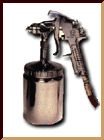 |
|
|
Distressing Wood
Old is hip and a seemingly important part of any project nowadays is the ability to falsify its age. Distressing -- also known as antiquing -- is used to age contemporary pieces and there are many variation on this theme. One of the more extreme approaches is to throw the project into the sea and let it crash against the beach for a few hours, if not days (it helps to tie it to something solid so that it doesn't float away of course!). Below are a few of the more accessible ways to age your projects. But, the best guide of all is to look at original antiques to try and mimic the same marks and scratches. Having said that, do not try to fake the marks with a chisel or knife as these will look false.
1. Nuts and bolts
Take a handful of nuts and bolts and put them in a canvas bag. Use this to strike the wood, producing dents and bruises in the wood's surface. Make sure that you hit the wood in a random fashion: do not plan out a hitting strategy first, as this tends to result in a regular pattern. Concentrate on the edges of a table and on the legs -- areas where the most wear and tear is likely to occur in old furniture.
2. Stain
Once distressed, smear the surface with a water-based stain. Take special care to run the stain into all of the dents and bruises so that they will appear darker. Once the stain is satisfactory, seal the wood using a shellac sealer. This will hold the stain in.
3. Cup Rings
Old table tops typically suffer from cup rings. These are caused by mugs of steaming-hot coffee being placed onto the wood, or by a film of alcohol on the underside of a beer glass. To replicate such a mark, fill a round-based metal container (such as a canned food tin) with hot water and wet its underside. Leave this on the wooden surface for about ten minutes to produce a dark ring.
4. Dirt stains
Mix alcohol and pigment with French polish and apply with a brush. Cover the entire surface with this concoction and rub well into the wood to create a darker finish. After this mixture has dried, apply a coat of clear polish. Once this has been applied, buff the product using firstly a circular motion, but finishing with a straight motion (with the grain). Stop short of creating the sheen that you would usually want to make. Once this is done, rub 000 wire wool along the grain to dull the polish a little more.
5. Paste Wax
Finally apply a coat of dark-colored paste wax to increase the aged appearance of the piece.